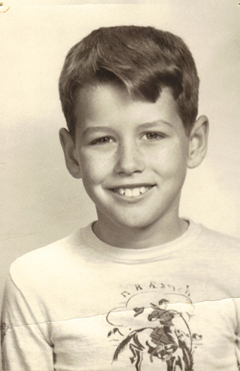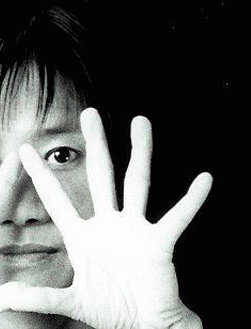Nobuho Nagasawa studied at the State Academy of Fine Arts in Maastricht, the Netherlands, from 1978 to 1982. Then from 1982 to 1985, she studied at Hochschule der Kunste Berlin, in Germany. In 1986 and 1987, she was at the California Institute of Arts in Valencia, California.
Work Title: Bird Calling (1), Room with Feathers
Work Date: 2006
Work Location: Sinop, Turkey
Nagasawa’s accompanying statement:
This installation took place in the Children’s Section of the Sinop Penitentiary. The installation consisted of light, shadows, and the sounds of birdsongs. A few hundred blue feathers hung from the ceiling and were lit by spotlights, projecting shadows of the feathers on the stone wall. As viewers walked between the hanging feathers, the shadows cast by their own bodies overlapped the feathers that moved in the air. The only light that came into the harsh stone room was through the punched holes of a rusted steel plate that covered the three windows. Songs of the local Turkish birds enveloped the space, evoking the desire to be free from confinement.
and
Work Title: Banned, Censored, Challenged: Banned in the USA
Work Date Years: 1993-1996
Work Location: Vermont Square Branch Library, Los Angeles, California.
Nagasawa’s accompanying statement:
In Banned, Censored, Challenged, a glass topped table functioned as a reference desk next to the library check out counter. Sandblasted text on glass listed titles of 141 books that have been banned, censored and challenged at American public libraries and schools between 1895 and 1994.
A magnifying glass with a fig leaf sandblasted on its surface was placed at the center of the table. The fig leaf has long been a symbol for “concealed” knowledge: Adam and Eve each wore a fig leaf apron to cover their nakedness in what may be Western history’s first act of censorship.
Placed on the check out counter was another provocative research aid - a reference guide to book censorship in the form of an old-fashioned library card catalog drawer. The drawer contained the aforementioned 141 titles in alphabetic order.
and
Work Title: Counting on the Moon
Work Date: 2006
Work Location: Sinop, Turkey
Nagasawa’s accompanying statement:
In the waiting room of the medical facility of (the Sinop Penitentiary, Children’s Section), an image of the artist’s hands holding a moon was printed on vinyl and hung in front of the window, casting the shadow of the window’s bars from behind, similar to a large light box. Opposite the image was a TV monitor, representing an image of a moon held between the artist’s lips. The moon rotated twenty-eight times in a loop, suggesting the phases of the moon. Since the Islamic calendar is based on the lunar calendar, this piece is about time and the endless counting prisoners must endure as they wait in the prison, especially in a medical facility, where this piece is installed.
and
Work Title: Cloud of Mushroom Soup
Work Date: 1992
Work Location: Daniel Saxon Gallery, Los Angeles, California
Nagasawa’s accompanying statement:
The atomic bomb (cloud depicted on the Campbells’ label) known as “Dirty Harry” was just one of ninety-seven nuclear tests that took place in Nevada between 1951 and 1958. Many “Cowboy Western” style Hollywood movies were being filmed on site at exactly the same time as these tests, in the deserts of the American Southwest.
Questions have been subsequently raised about the rate of Hollywood-industry related cancer deaths and their possible link to 1950’s atom bomb tests. There are an unusually high number of cancer deaths among the cast and crew members of the movie “The Conqueror,” for example, which was shot near the nuclear testing range at Yucca Flat, Nevada, in 1954. The film was based on the conquests of the 13th century warrior Genghis Kahn, starred the late John Wayne, and had a script that called for the some of the dustiest, grimiest battle scenes ever filmed. During the shooting actors and extras rolled in the dirt in mock battle scenes while desert winds blew incessantly.
Of the original two hundred and twenty cast and crew members of “The Conqueror,” one hundred and fifty were later contacted. Ninety-one had developed cancer. Forty-six of those, including John Wayne, Susan Hayward, Agnes Moorehead, and producer-director Dick Powell, died of the disease by 1980. As it turns out, the victims were not only the film crew, but also the three hundred Native American Shivit tribe people used as extras for the movie, and the residents of St. George, Utah, though the latter lived 145 miles from ground zero. In fact, more than 950 residents and former residents of Utah, Nevada, and Arizona have filed $2 billion in claims against the federal government, seeking compensation for damages they say are related to nuclear fallout.
The Hollywood aspect of the tragedy continued when 60 tons of radioactive earth from Utah was transported to a Culver City studio by RKO Pictures, in order to recreate a desert set for additional filming. After the filming was completed, the dirt was distributed over the Hollywood area. To this day, parts of Hollywood may still be radioactive, since the half-life of plutonium is estimated at 24,000 years.
Proceeding with her research, the artist was horrified to discover that the United States government had complete awareness of the danger of the nuclear tests. The blasts were detonated only when the wind blew east, away from California, and toward Utah and northern Arizona, which are inhabited primarily by Mormons and Native Americans.
The exhibit…while addressing an array of ecological concerns, also exposed the human frailty buried beneath the glitz and machismo of Hollywood’s “Cowboy” genre.
-
(Courtesy of Murayama Fine Art, artnet and its Artist Works Catalogues)






